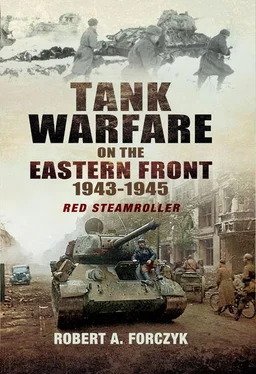However, the main Soviet play came that evening, when Vatutin decided to commit the airborne troops to reinforce and expand the bridgehead. The airborne operation was a three-star mess from the beginning, starting with a 24-hour delay due to weather and logistical problems, then shortages of transport aircraft. Instead of committing all three brigades (which would have delayed the operation further), Vatutin decided to go with two brigades and the last-minute planning changes led to chaos. At 1930 hours on 24 September, the Soviet transports began dropping paratroops from the 3 GAB and 5 GAB southwest of the Bukrin bridgehead. The drops were badly scattered and most of the 4,575 paratroops who jumped missed their drop zones; instead they landed on top of the Panzergrenadier-Regiment 73, which by the fortunes of war was just arriving in sector. With the sky full of white parachutes, the Panzergrenadiers had a field day and engaged the paratroopers with automatic weapons and light flak. In the first 24 hours, the Germans captured or killed 901 paratroopers and the airborne operation failed to reinforce the Bukrin bridgehead. {181}
Nehring tried to organize a counter-attack against the Bukrin bridgehead as quickly as possible, but he only had part of the 19.Panzer-Division and part of 57.Infanterie-Division, which he felt was insufficient to overrun the enemy position. In fact, the Soviets had not yet succeeded in bringing more than a few heavy weapons across the Dnepr and no tanks, so the Soviet position was still quite tenuous. However, the Germans were not sure exactly how many Soviet troops were in the bridgehead and Nehring decided to wait for further reinforcements. Von Manstein sent him Kampfgruppen from the 7.Panzer-Division and 20.Panzergrenadier-Division, but this delayed the counter-attack until 29 September. The Soviets used this week-long respite wisely, digging in their infantry and using a small number of pontoons to begin ferrying tanks and artillery across the river on 26 September. By the end of that day, Rybalko had 14 tanks and 18 120mm mortars on the western side of the river and Moskalenko was able to push 17 tanks, 27 76.2mm guns and 51 45mm anti-tank guns across on the first day. {182}
Just before the German counter-offensive began, von Knobelsdorff’s XXXXVIII Panzerkorps assumed command over all German formations in the Kanev-Bukrin sector, which was not a very bright idea since all the preparations for the counter-attack had been done by Nehring’s staff. The German counter-attack on 29–30 September inflicted over 2,800 casualties on the defenders and regained some ground, but was shocked to encounter dug in anti-tank guns and tanks. Air attacks by Fliegerkorps VIII succeeded in destroying one Soviet pontoon bridge, but this was soon rebuilt. Even worse, the Germans discovered that the Soviets had crammed elements of 19 rifle divisions into the Bukrin bridgehead. {183} Consequently, von Knobelsdorff decided to shift to the defensive and bombard the bridgehead with his artillery in order to conserve his own forces.
Meanwhile, the III. Panzerkorps succeeded in crossing the Dnepr in orderly fashion at Cherkassy and Wiking moved to the west bank on 27 September. However, the situation with XI Armeekorps and XXXXVII Panzerkorps at Kremenchug was much more chaotic, due to traffic jams at the bridges. Amazingly, the Soviet VVS failed to bomb these packed German formations awaiting to cross, which could have inflicted great slaughter. Yet even before all of the German forces had crossed, Konev’s pursuing forces managed to seize toeholds across the Dnepr south of Kremenchug; on the night of 25–26 September at Uspenka and on 27–28 September at Deriyivka. Wöhler’s AOK 8 had not yet had time to create a continuous front behind the Dnepr and were particularly thin in this sector: only the much-depleted 106. Infanterie-Division was nearby and it could do little to prevent the 7 GA from expanding its bridgeheads. Even worse, Konev’s bridgeheads were near the boundary between Wöhler’s AOK 8 and Mackensen’s PzAOK 1. By the time that the Germans rushed the SS-Kavallerie-Division and Kampfgruppen from 23.Panzer-Division and Großdeutschland to this sector, the Soviets were already poised to break out and push southwest. German efforts to establish a viable defensive perimeter around the Soviet bridgeheads were hindered by the severe lack of infantry. Unit commanders were forced to start cannibalizing their rear area support troops and staff to refill depleted infantry units, which noticeably reduced the operational efficiency of the Wehrmacht.
Von Mackensen managed to conduct a fairly orderly crossing with PzAOK 1 at Dnepropetrovsk, but he was ordered to hold a bridgehead on the east side of the Dnepr at Zaporozhe with his XXXX Panzerkorps in order to protect the Dnepr dams. This dam provided hydroelectric power that was important for German war industries in the region, including tank repair facilities at Dnepropetrovsk amd Nikopol. Furthermore, Hitler did not want to completely abandon the east bank of the Dnepr and was still toying with fanciful ideas about future offensives to reconquer the Donbas. Consequently, von Mackensen was forced to keep six divisions of his PzAOK 1 on the east bank, including most of 9.Panzer-Division, where they could be relentlessly pounded into ruin by Malinovsky’s 3rd and 8th Guards Armies. In order to stiffen the anti-tank capability of XXXX Panzerkorps, the Germans scraped together an ad hoc Kampfgruppe under Major Georg Baumunk from the remnants of schwere Panzerjäger-Regiment 656 and Sturmpanzer-Abteilung 216, consisting of 12 repaired Ferdinands and 13 Sturmpanzers. Major Gerhard Willing’s s. Pz.Abt.506 also arrived from Germany with 45 new Tigers to reinforce the Zaporozhe bridgehead. Baumunk’s Ferdinands and Willing’s Tigers repulsed repeated Soviet attacks on the bridgehead for three weeks. Malinovsky committed the 23 TC and 1 GMC to overrun the bridgehead. On 10 October, Baumunk’s Ferdinands repulsed a major Soviet armoured attack, claiming 48 enemy tanks destroyed. Yet despite the excellence of the Ferdinand and Tigers as defensive weapons, the Soviet artillery gradually pulverized the German infantry positions and PzAOK 1 was forced to evacuate the Zaporozhe bridgehead on 15 October. {184} Willing lost seven Tigers in the bridgehead battle and most of the remainder were damaged, leaving only seven out of the original 45 operational.
Similarly, Hollidt’s AOK 6 (which was now subordinate to Heeresgruppe A), was forced to hold Melitopol in the vain hope of protecting the rail link to the Crimea. Hollidt’s forces reached the illusory Wotan Stellung on 20 September and were shocked to find no prepared defences. All troops, including Panzertruppen, were ordered to dig in immediately. Unteroffizier Erich Hager, a Pz IV crewmen in the II.Pz. Rgt. 39 in 17.Panzer-Division, recounted digging in every night and fending off Soviet probing attacks every day. The weather was already turning cold due to frequent drenching rain and Hager wrote, ‘we look like pigs’. {185} German front-line morale was increasingly brittle. Tolbukhin’s forces soon arrived near Melitopol in strength and on 26 September, began a massive assault against AOK 6’s left flank with the 5th Shock Army and 44th Army. This sector was held by the battered IV Armeekorps, which included two Luftwaffe Feld-Divisionen. Tolbukhin committed the 11 TC, 20 TC and 4 GMC against IV Armeekorps, along with a large amount of infantry and artillery. In order to prevent a breakthrough, Hollidt rushed the 17.Panzer-Division to this sector and in five days of heavy fighting, the Germans claimed to have destroyed 181 enemy tanks.
The OKH dispatched forces to reinforce Hollidt, including the I./Pz.Rgt. 2, intended for the 13.Panzer-Division; this battalion was the first equipped with the Panther Ausf A model. The Panther Ausf A incorporated a number of minor product improvements that had been unable to include in the original Ausf D model, but it still possessed the same reliability issues. On 10 October, the new Panthers were committed to a counter-attack to repulse a local breakthrough by the 20 TC and 4 GMC, which resulted in the ‘tank battle of Oktoberfeld.’ As usual, the superior firepower of the Panthers inflicted punishing losses on the opposing T-34s – the Germans claimed about 60 knocked out – but numerous Panthers dropped out with mechanical defects. Despite heavy losses, the Soviets were often able to recover their damaged tanks and they kept pounding at AOK 6’s front throughout October. Hollidt was finally forced to yield Melitopol on 23 October and Tolbukhin made a massive push that sent AOK 6 in pell-mell retreat for the Dnepr. While two German corps retreated toward Nikopol, the XXXXIV Armeekorps (Gruppe Becker) retreated toward Kherson with the 13.Panzer-Division, the Panther battalion and two infantry divisions. The Panthers were particularly useful during the retreat, keeping 4 GMC’s armour at bay and preventing the Soviets from cutting off the escape of Gruppe Becker. Although Gruppe Becker succeeded in crossing safely at Kherson, very few Panthers of the I.Pz.Rgt. 2 were still operational. The IV and XXIX Armeekorps were less fortunate, in that rather than crossing at Nikopol, Hitler ordered them to remain on the eastern bank to protect the manganese ore mines near Nikopol; fighting for the Nikopol bridgehead would continue for nearly 100 days. [38]
Читать дальше








![John Stieber - Against the Odds - Survival on the Russian Front 1944-1945 [2nd Edition]](/books/405234/john-stieber-against-the-odds-survival-on-the-russian-front-1944-1945-2nd-edition-thumb.webp)



